MKTG101 Marketing Portfolio: Applying Marketing Concepts to Examples
VerifiedAdded on 2023/06/12
|10
|2434
|330
Portfolio
AI Summary
This marketing portfolio presents a collection of seven real-world examples from 2016-2018, illustrating key marketing concepts. It covers market research, demonstrating its use in developing marketing plans with the Oriel Living case. The impact of competition is examined through Coca-Cola's response to Pepsi. A PESTEL analysis explores the introduction of handheld digital fabric printers, while a SWOT analysis evaluates Puma's strategic decision-making. Segmentation, targeting, and positioning (STP) are discussed in the context of the beverage industry, and finally, new product/service launches are analyzed through the successes of Panacea and the failures of Samsung Note 7. The portfolio emphasizes the importance of understanding and applying these concepts in dynamic market environments.
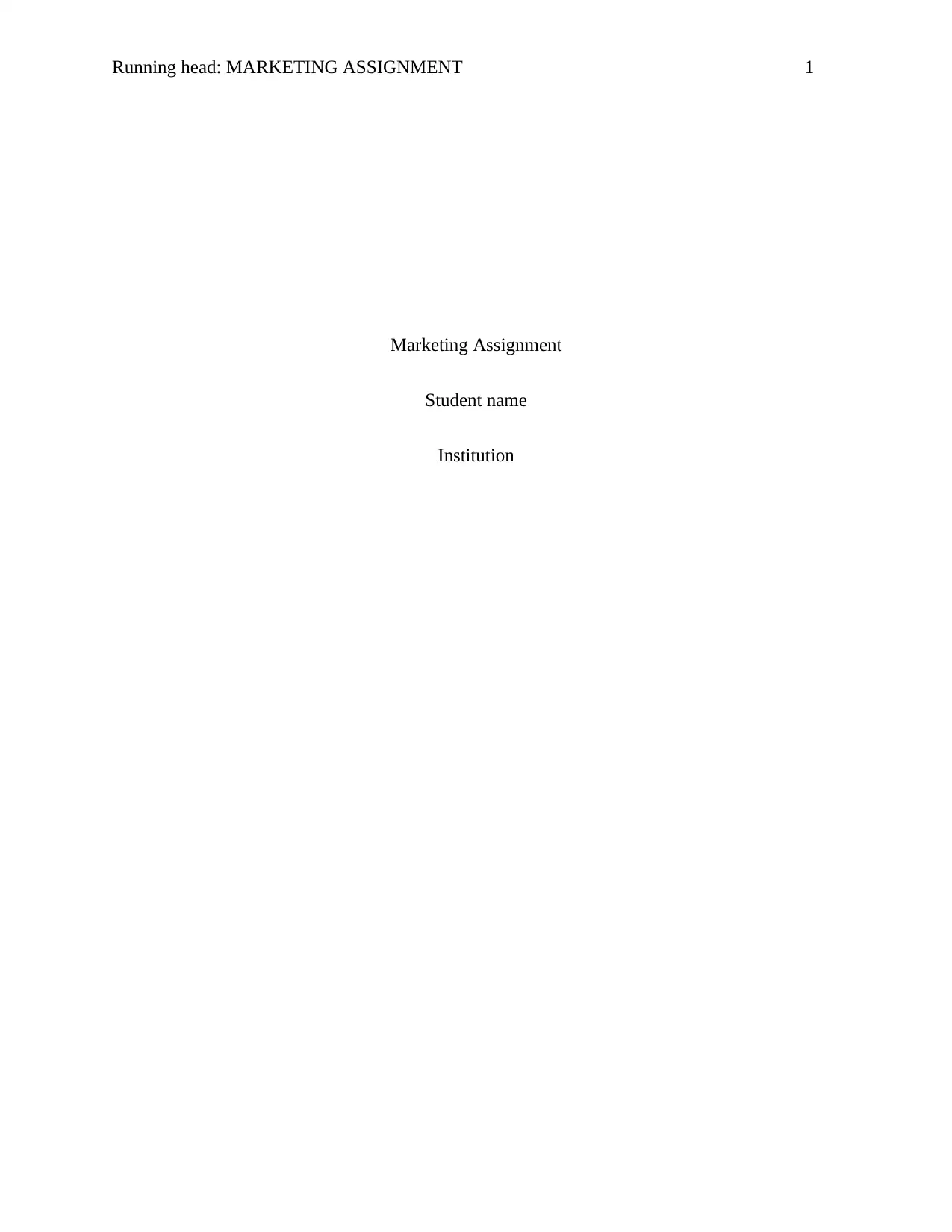
Running head: MARKETING ASSIGNMENT 1
Marketing Assignment
Student name
Institution
Marketing Assignment
Student name
Institution
Paraphrase This Document
Need a fresh take? Get an instant paraphrase of this document with our AI Paraphraser
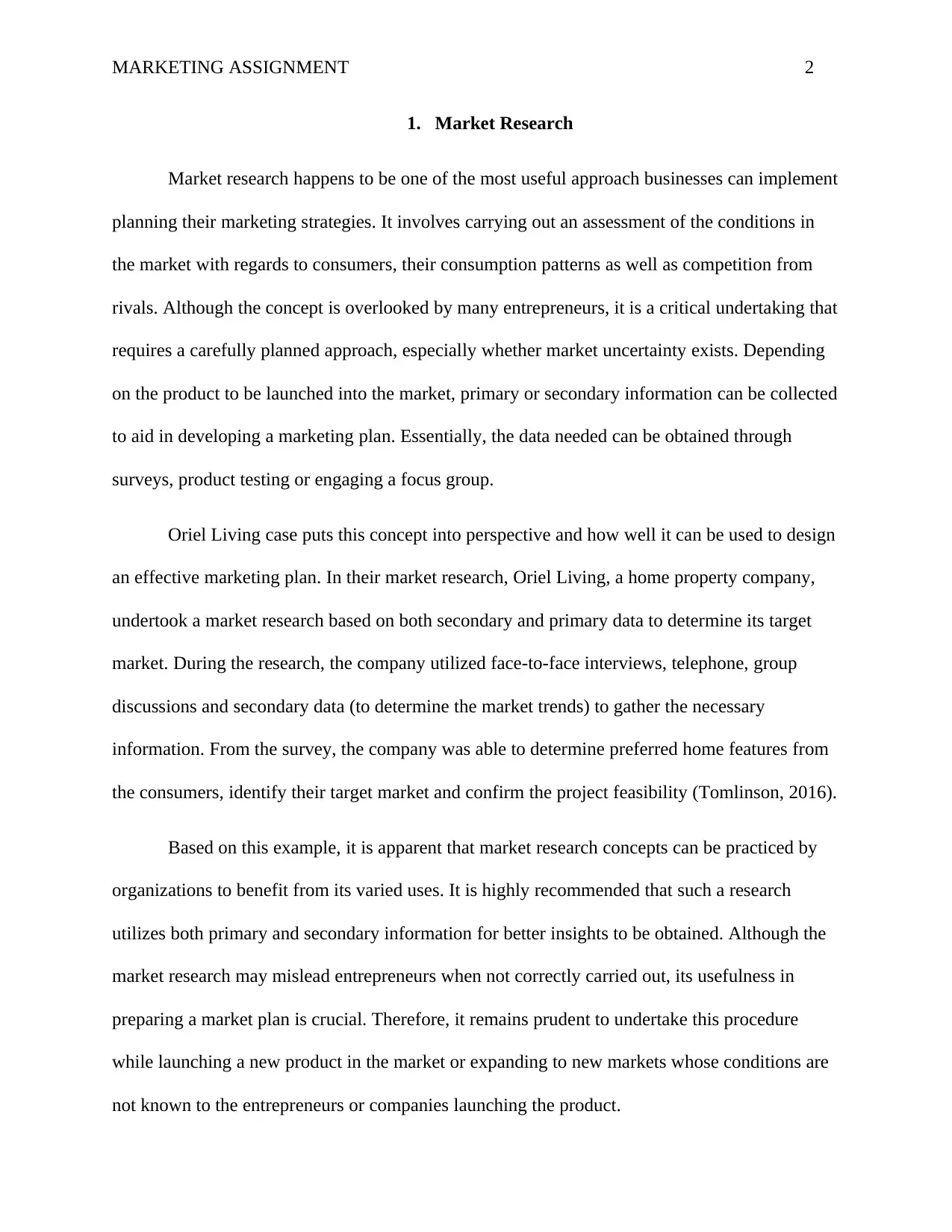
MARKETING ASSIGNMENT 2
1. Market Research
Market research happens to be one of the most useful approach businesses can implement
planning their marketing strategies. It involves carrying out an assessment of the conditions in
the market with regards to consumers, their consumption patterns as well as competition from
rivals. Although the concept is overlooked by many entrepreneurs, it is a critical undertaking that
requires a carefully planned approach, especially whether market uncertainty exists. Depending
on the product to be launched into the market, primary or secondary information can be collected
to aid in developing a marketing plan. Essentially, the data needed can be obtained through
surveys, product testing or engaging a focus group.
Oriel Living case puts this concept into perspective and how well it can be used to design
an effective marketing plan. In their market research, Oriel Living, a home property company,
undertook a market research based on both secondary and primary data to determine its target
market. During the research, the company utilized face-to-face interviews, telephone, group
discussions and secondary data (to determine the market trends) to gather the necessary
information. From the survey, the company was able to determine preferred home features from
the consumers, identify their target market and confirm the project feasibility (Tomlinson, 2016).
Based on this example, it is apparent that market research concepts can be practiced by
organizations to benefit from its varied uses. It is highly recommended that such a research
utilizes both primary and secondary information for better insights to be obtained. Although the
market research may mislead entrepreneurs when not correctly carried out, its usefulness in
preparing a market plan is crucial. Therefore, it remains prudent to undertake this procedure
while launching a new product in the market or expanding to new markets whose conditions are
not known to the entrepreneurs or companies launching the product.
1. Market Research
Market research happens to be one of the most useful approach businesses can implement
planning their marketing strategies. It involves carrying out an assessment of the conditions in
the market with regards to consumers, their consumption patterns as well as competition from
rivals. Although the concept is overlooked by many entrepreneurs, it is a critical undertaking that
requires a carefully planned approach, especially whether market uncertainty exists. Depending
on the product to be launched into the market, primary or secondary information can be collected
to aid in developing a marketing plan. Essentially, the data needed can be obtained through
surveys, product testing or engaging a focus group.
Oriel Living case puts this concept into perspective and how well it can be used to design
an effective marketing plan. In their market research, Oriel Living, a home property company,
undertook a market research based on both secondary and primary data to determine its target
market. During the research, the company utilized face-to-face interviews, telephone, group
discussions and secondary data (to determine the market trends) to gather the necessary
information. From the survey, the company was able to determine preferred home features from
the consumers, identify their target market and confirm the project feasibility (Tomlinson, 2016).
Based on this example, it is apparent that market research concepts can be practiced by
organizations to benefit from its varied uses. It is highly recommended that such a research
utilizes both primary and secondary information for better insights to be obtained. Although the
market research may mislead entrepreneurs when not correctly carried out, its usefulness in
preparing a market plan is crucial. Therefore, it remains prudent to undertake this procedure
while launching a new product in the market or expanding to new markets whose conditions are
not known to the entrepreneurs or companies launching the product.
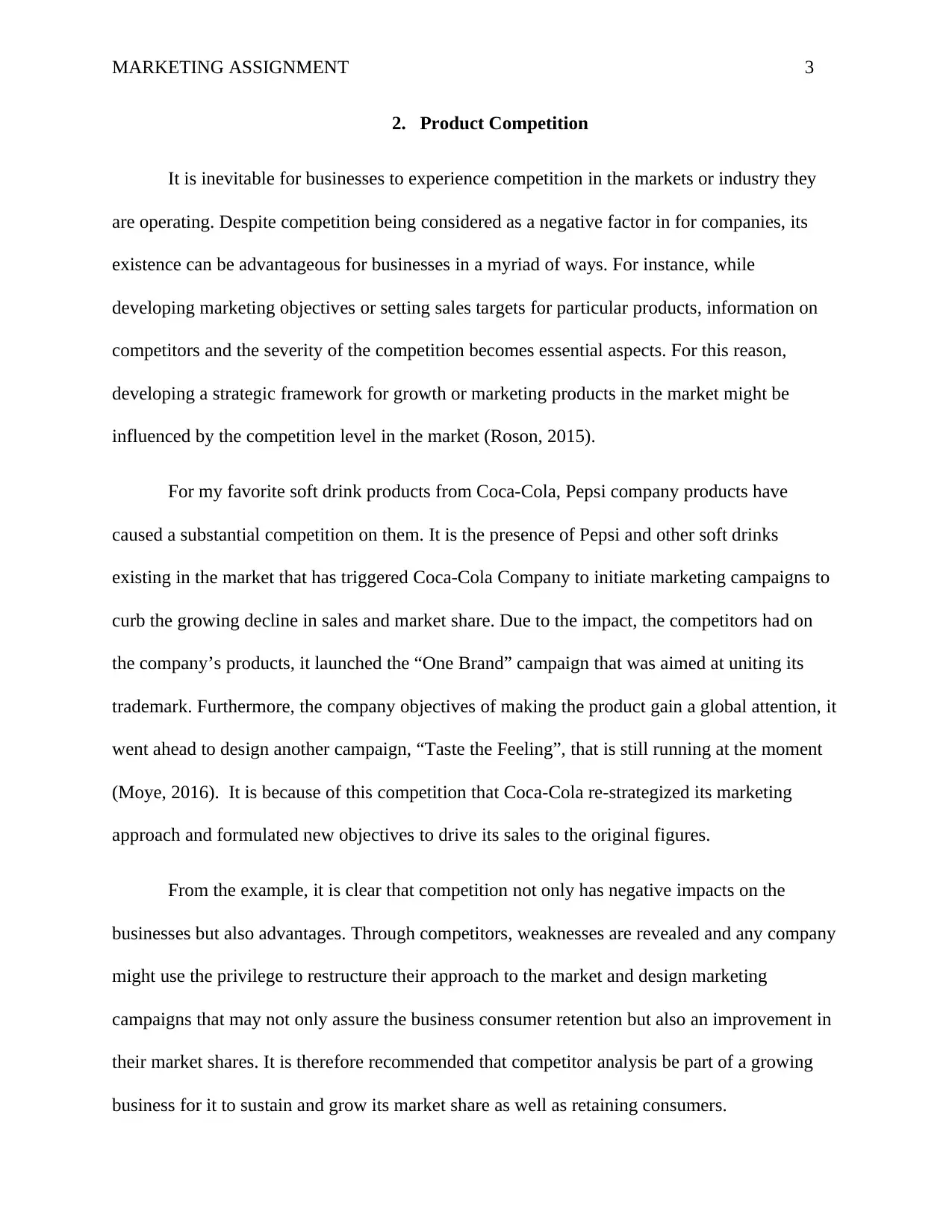
MARKETING ASSIGNMENT 3
2. Product Competition
It is inevitable for businesses to experience competition in the markets or industry they
are operating. Despite competition being considered as a negative factor in for companies, its
existence can be advantageous for businesses in a myriad of ways. For instance, while
developing marketing objectives or setting sales targets for particular products, information on
competitors and the severity of the competition becomes essential aspects. For this reason,
developing a strategic framework for growth or marketing products in the market might be
influenced by the competition level in the market (Roson, 2015).
For my favorite soft drink products from Coca-Cola, Pepsi company products have
caused a substantial competition on them. It is the presence of Pepsi and other soft drinks
existing in the market that has triggered Coca-Cola Company to initiate marketing campaigns to
curb the growing decline in sales and market share. Due to the impact, the competitors had on
the company’s products, it launched the “One Brand” campaign that was aimed at uniting its
trademark. Furthermore, the company objectives of making the product gain a global attention, it
went ahead to design another campaign, “Taste the Feeling”, that is still running at the moment
(Moye, 2016). It is because of this competition that Coca-Cola re-strategized its marketing
approach and formulated new objectives to drive its sales to the original figures.
From the example, it is clear that competition not only has negative impacts on the
businesses but also advantages. Through competitors, weaknesses are revealed and any company
might use the privilege to restructure their approach to the market and design marketing
campaigns that may not only assure the business consumer retention but also an improvement in
their market shares. It is therefore recommended that competitor analysis be part of a growing
business for it to sustain and grow its market share as well as retaining consumers.
2. Product Competition
It is inevitable for businesses to experience competition in the markets or industry they
are operating. Despite competition being considered as a negative factor in for companies, its
existence can be advantageous for businesses in a myriad of ways. For instance, while
developing marketing objectives or setting sales targets for particular products, information on
competitors and the severity of the competition becomes essential aspects. For this reason,
developing a strategic framework for growth or marketing products in the market might be
influenced by the competition level in the market (Roson, 2015).
For my favorite soft drink products from Coca-Cola, Pepsi company products have
caused a substantial competition on them. It is the presence of Pepsi and other soft drinks
existing in the market that has triggered Coca-Cola Company to initiate marketing campaigns to
curb the growing decline in sales and market share. Due to the impact, the competitors had on
the company’s products, it launched the “One Brand” campaign that was aimed at uniting its
trademark. Furthermore, the company objectives of making the product gain a global attention, it
went ahead to design another campaign, “Taste the Feeling”, that is still running at the moment
(Moye, 2016). It is because of this competition that Coca-Cola re-strategized its marketing
approach and formulated new objectives to drive its sales to the original figures.
From the example, it is clear that competition not only has negative impacts on the
businesses but also advantages. Through competitors, weaknesses are revealed and any company
might use the privilege to restructure their approach to the market and design marketing
campaigns that may not only assure the business consumer retention but also an improvement in
their market shares. It is therefore recommended that competitor analysis be part of a growing
business for it to sustain and grow its market share as well as retaining consumers.
⊘ This is a preview!⊘
Do you want full access?
Subscribe today to unlock all pages.

Trusted by 1+ million students worldwide
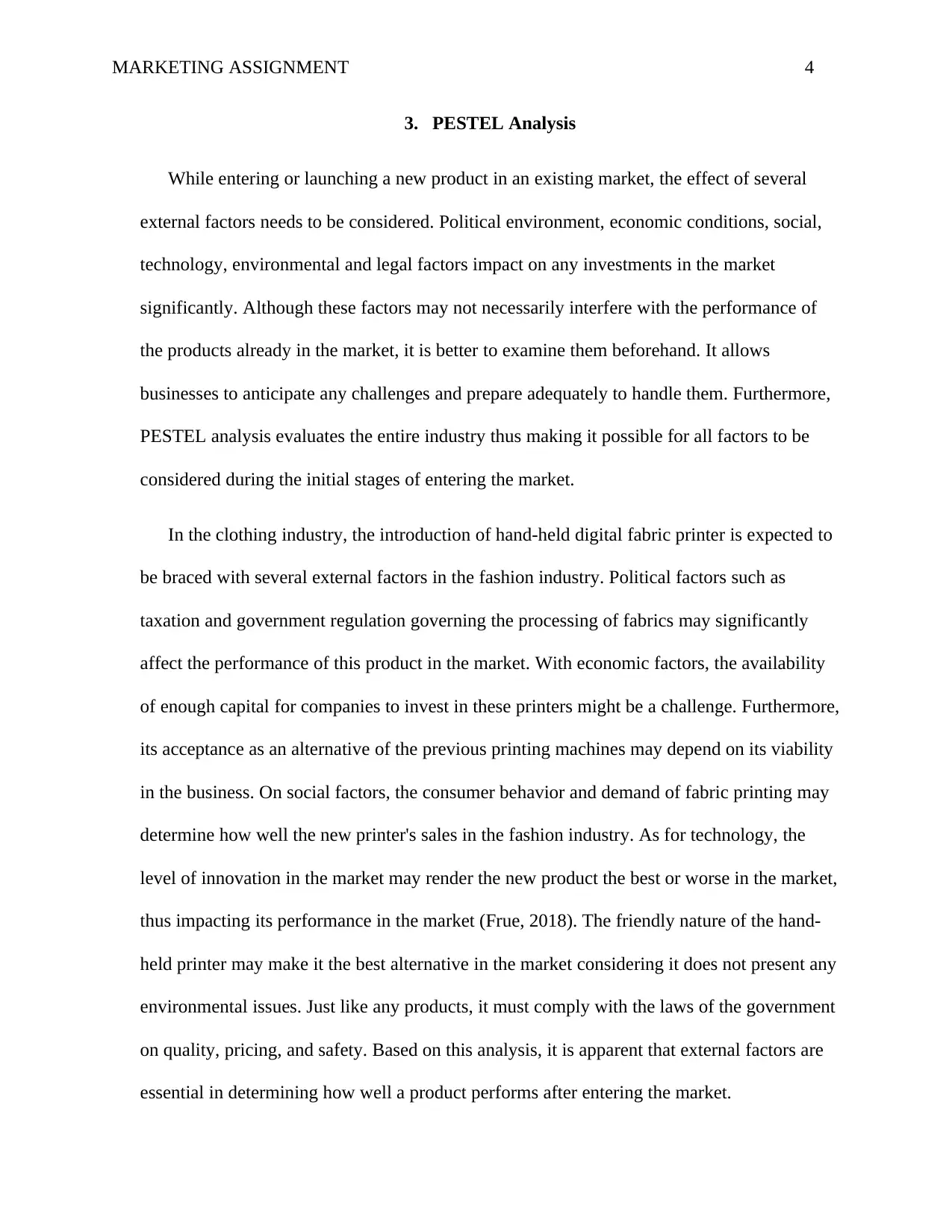
MARKETING ASSIGNMENT 4
3. PESTEL Analysis
While entering or launching a new product in an existing market, the effect of several
external factors needs to be considered. Political environment, economic conditions, social,
technology, environmental and legal factors impact on any investments in the market
significantly. Although these factors may not necessarily interfere with the performance of
the products already in the market, it is better to examine them beforehand. It allows
businesses to anticipate any challenges and prepare adequately to handle them. Furthermore,
PESTEL analysis evaluates the entire industry thus making it possible for all factors to be
considered during the initial stages of entering the market.
In the clothing industry, the introduction of hand-held digital fabric printer is expected to
be braced with several external factors in the fashion industry. Political factors such as
taxation and government regulation governing the processing of fabrics may significantly
affect the performance of this product in the market. With economic factors, the availability
of enough capital for companies to invest in these printers might be a challenge. Furthermore,
its acceptance as an alternative of the previous printing machines may depend on its viability
in the business. On social factors, the consumer behavior and demand of fabric printing may
determine how well the new printer's sales in the fashion industry. As for technology, the
level of innovation in the market may render the new product the best or worse in the market,
thus impacting its performance in the market (Frue, 2018). The friendly nature of the hand-
held printer may make it the best alternative in the market considering it does not present any
environmental issues. Just like any products, it must comply with the laws of the government
on quality, pricing, and safety. Based on this analysis, it is apparent that external factors are
essential in determining how well a product performs after entering the market.
3. PESTEL Analysis
While entering or launching a new product in an existing market, the effect of several
external factors needs to be considered. Political environment, economic conditions, social,
technology, environmental and legal factors impact on any investments in the market
significantly. Although these factors may not necessarily interfere with the performance of
the products already in the market, it is better to examine them beforehand. It allows
businesses to anticipate any challenges and prepare adequately to handle them. Furthermore,
PESTEL analysis evaluates the entire industry thus making it possible for all factors to be
considered during the initial stages of entering the market.
In the clothing industry, the introduction of hand-held digital fabric printer is expected to
be braced with several external factors in the fashion industry. Political factors such as
taxation and government regulation governing the processing of fabrics may significantly
affect the performance of this product in the market. With economic factors, the availability
of enough capital for companies to invest in these printers might be a challenge. Furthermore,
its acceptance as an alternative of the previous printing machines may depend on its viability
in the business. On social factors, the consumer behavior and demand of fabric printing may
determine how well the new printer's sales in the fashion industry. As for technology, the
level of innovation in the market may render the new product the best or worse in the market,
thus impacting its performance in the market (Frue, 2018). The friendly nature of the hand-
held printer may make it the best alternative in the market considering it does not present any
environmental issues. Just like any products, it must comply with the laws of the government
on quality, pricing, and safety. Based on this analysis, it is apparent that external factors are
essential in determining how well a product performs after entering the market.
Paraphrase This Document
Need a fresh take? Get an instant paraphrase of this document with our AI Paraphraser
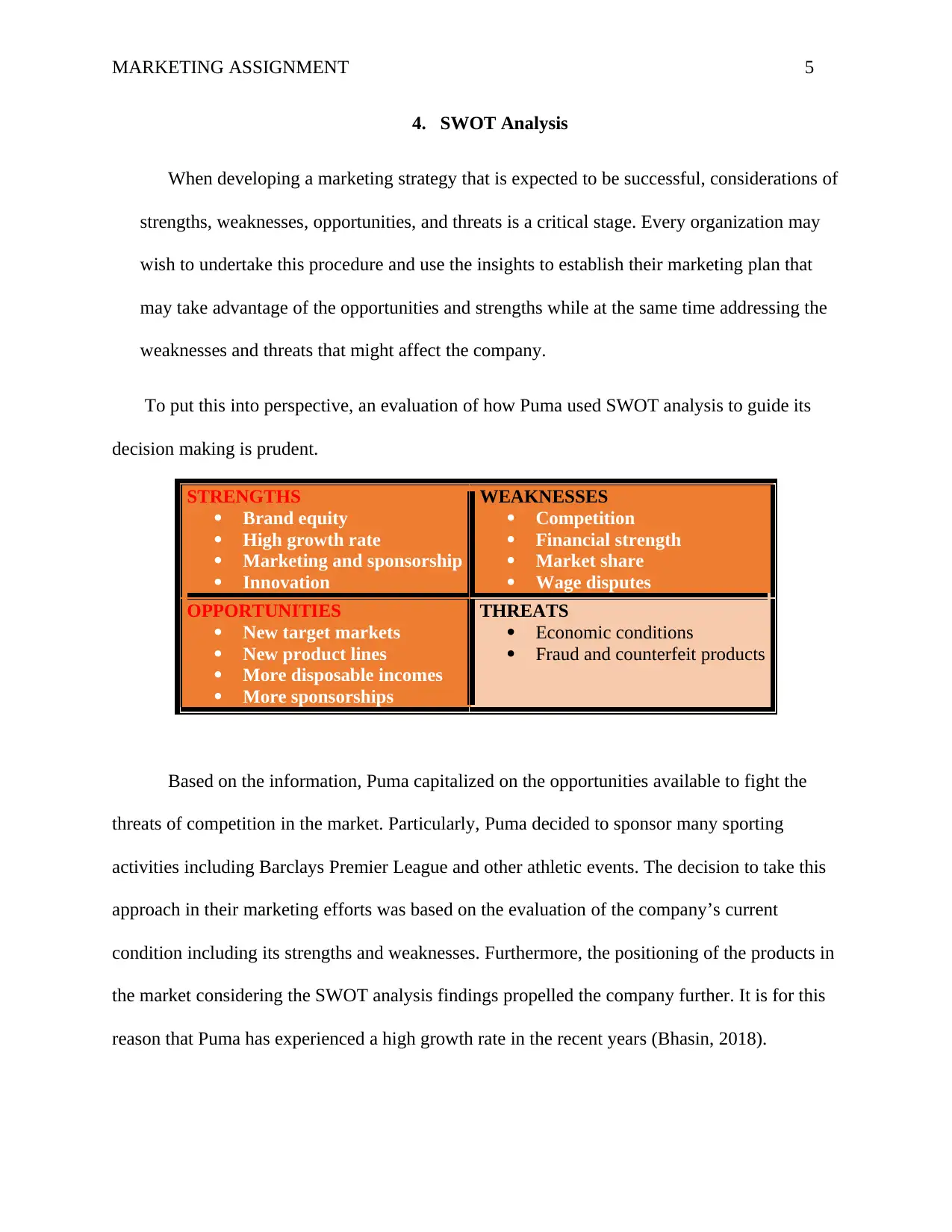
MARKETING ASSIGNMENT 5
4. SWOT Analysis
When developing a marketing strategy that is expected to be successful, considerations of
strengths, weaknesses, opportunities, and threats is a critical stage. Every organization may
wish to undertake this procedure and use the insights to establish their marketing plan that
may take advantage of the opportunities and strengths while at the same time addressing the
weaknesses and threats that might affect the company.
To put this into perspective, an evaluation of how Puma used SWOT analysis to guide its
decision making is prudent.
Based on the information, Puma capitalized on the opportunities available to fight the
threats of competition in the market. Particularly, Puma decided to sponsor many sporting
activities including Barclays Premier League and other athletic events. The decision to take this
approach in their marketing efforts was based on the evaluation of the company’s current
condition including its strengths and weaknesses. Furthermore, the positioning of the products in
the market considering the SWOT analysis findings propelled the company further. It is for this
reason that Puma has experienced a high growth rate in the recent years (Bhasin, 2018).
STRENGTHS
Brand equity
High growth rate
Marketing and sponsorship
Innovation
WEAKNESSES
Competition
Financial strength
Market share
Wage disputes
OPPORTUNITIES
New target markets
New product lines
More disposable incomes
More sponsorships
THREATS
Economic conditions
Fraud and counterfeit products
4. SWOT Analysis
When developing a marketing strategy that is expected to be successful, considerations of
strengths, weaknesses, opportunities, and threats is a critical stage. Every organization may
wish to undertake this procedure and use the insights to establish their marketing plan that
may take advantage of the opportunities and strengths while at the same time addressing the
weaknesses and threats that might affect the company.
To put this into perspective, an evaluation of how Puma used SWOT analysis to guide its
decision making is prudent.
Based on the information, Puma capitalized on the opportunities available to fight the
threats of competition in the market. Particularly, Puma decided to sponsor many sporting
activities including Barclays Premier League and other athletic events. The decision to take this
approach in their marketing efforts was based on the evaluation of the company’s current
condition including its strengths and weaknesses. Furthermore, the positioning of the products in
the market considering the SWOT analysis findings propelled the company further. It is for this
reason that Puma has experienced a high growth rate in the recent years (Bhasin, 2018).
STRENGTHS
Brand equity
High growth rate
Marketing and sponsorship
Innovation
WEAKNESSES
Competition
Financial strength
Market share
Wage disputes
OPPORTUNITIES
New target markets
New product lines
More disposable incomes
More sponsorships
THREATS
Economic conditions
Fraud and counterfeit products
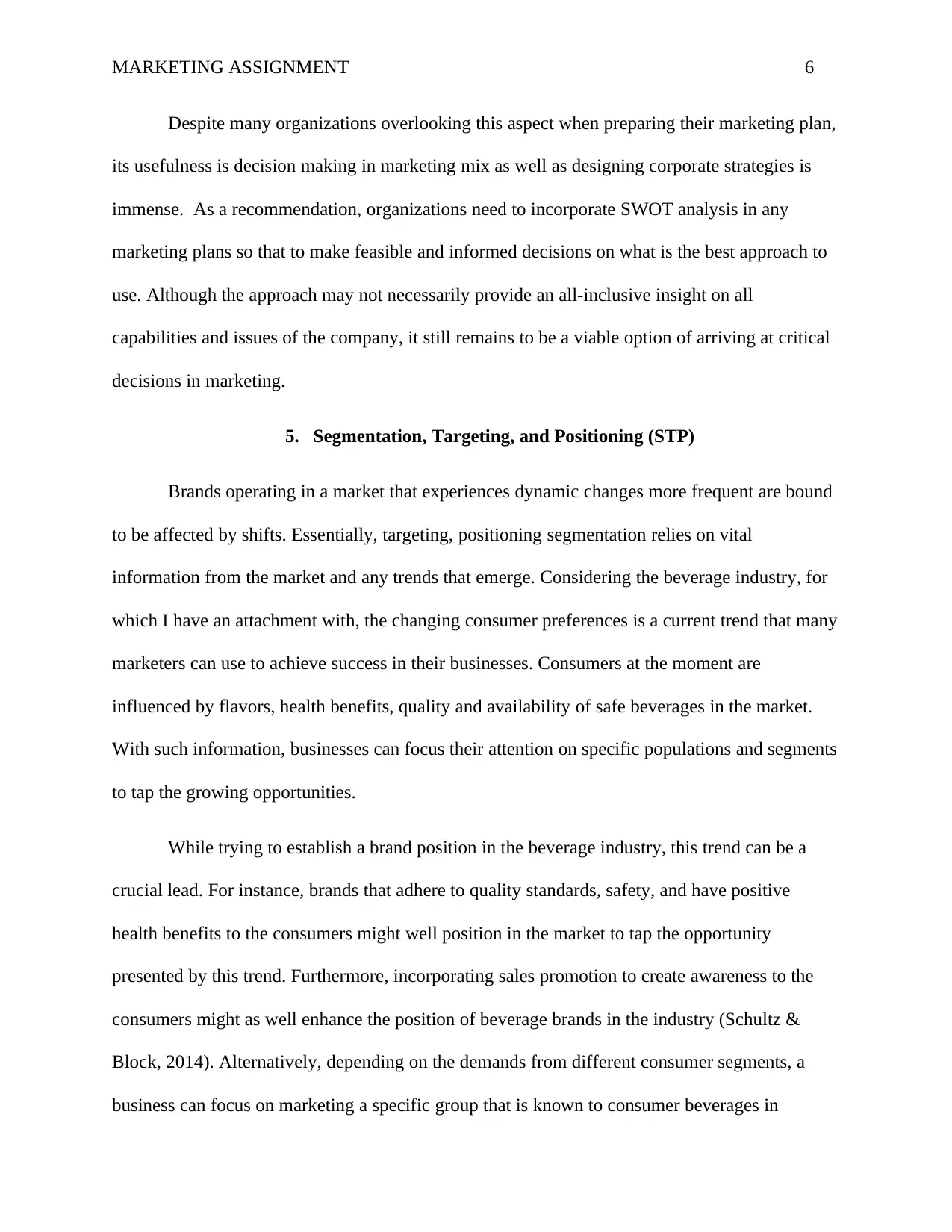
MARKETING ASSIGNMENT 6
Despite many organizations overlooking this aspect when preparing their marketing plan,
its usefulness is decision making in marketing mix as well as designing corporate strategies is
immense. As a recommendation, organizations need to incorporate SWOT analysis in any
marketing plans so that to make feasible and informed decisions on what is the best approach to
use. Although the approach may not necessarily provide an all-inclusive insight on all
capabilities and issues of the company, it still remains to be a viable option of arriving at critical
decisions in marketing.
5. Segmentation, Targeting, and Positioning (STP)
Brands operating in a market that experiences dynamic changes more frequent are bound
to be affected by shifts. Essentially, targeting, positioning segmentation relies on vital
information from the market and any trends that emerge. Considering the beverage industry, for
which I have an attachment with, the changing consumer preferences is a current trend that many
marketers can use to achieve success in their businesses. Consumers at the moment are
influenced by flavors, health benefits, quality and availability of safe beverages in the market.
With such information, businesses can focus their attention on specific populations and segments
to tap the growing opportunities.
While trying to establish a brand position in the beverage industry, this trend can be a
crucial lead. For instance, brands that adhere to quality standards, safety, and have positive
health benefits to the consumers might well position in the market to tap the opportunity
presented by this trend. Furthermore, incorporating sales promotion to create awareness to the
consumers might as well enhance the position of beverage brands in the industry (Schultz &
Block, 2014). Alternatively, depending on the demands from different consumer segments, a
business can focus on marketing a specific group that is known to consumer beverages in
Despite many organizations overlooking this aspect when preparing their marketing plan,
its usefulness is decision making in marketing mix as well as designing corporate strategies is
immense. As a recommendation, organizations need to incorporate SWOT analysis in any
marketing plans so that to make feasible and informed decisions on what is the best approach to
use. Although the approach may not necessarily provide an all-inclusive insight on all
capabilities and issues of the company, it still remains to be a viable option of arriving at critical
decisions in marketing.
5. Segmentation, Targeting, and Positioning (STP)
Brands operating in a market that experiences dynamic changes more frequent are bound
to be affected by shifts. Essentially, targeting, positioning segmentation relies on vital
information from the market and any trends that emerge. Considering the beverage industry, for
which I have an attachment with, the changing consumer preferences is a current trend that many
marketers can use to achieve success in their businesses. Consumers at the moment are
influenced by flavors, health benefits, quality and availability of safe beverages in the market.
With such information, businesses can focus their attention on specific populations and segments
to tap the growing opportunities.
While trying to establish a brand position in the beverage industry, this trend can be a
crucial lead. For instance, brands that adhere to quality standards, safety, and have positive
health benefits to the consumers might well position in the market to tap the opportunity
presented by this trend. Furthermore, incorporating sales promotion to create awareness to the
consumers might as well enhance the position of beverage brands in the industry (Schultz &
Block, 2014). Alternatively, depending on the demands from different consumer segments, a
business can focus on marketing a specific group that is known to consumer beverages in
⊘ This is a preview!⊘
Do you want full access?
Subscribe today to unlock all pages.

Trusted by 1+ million students worldwide
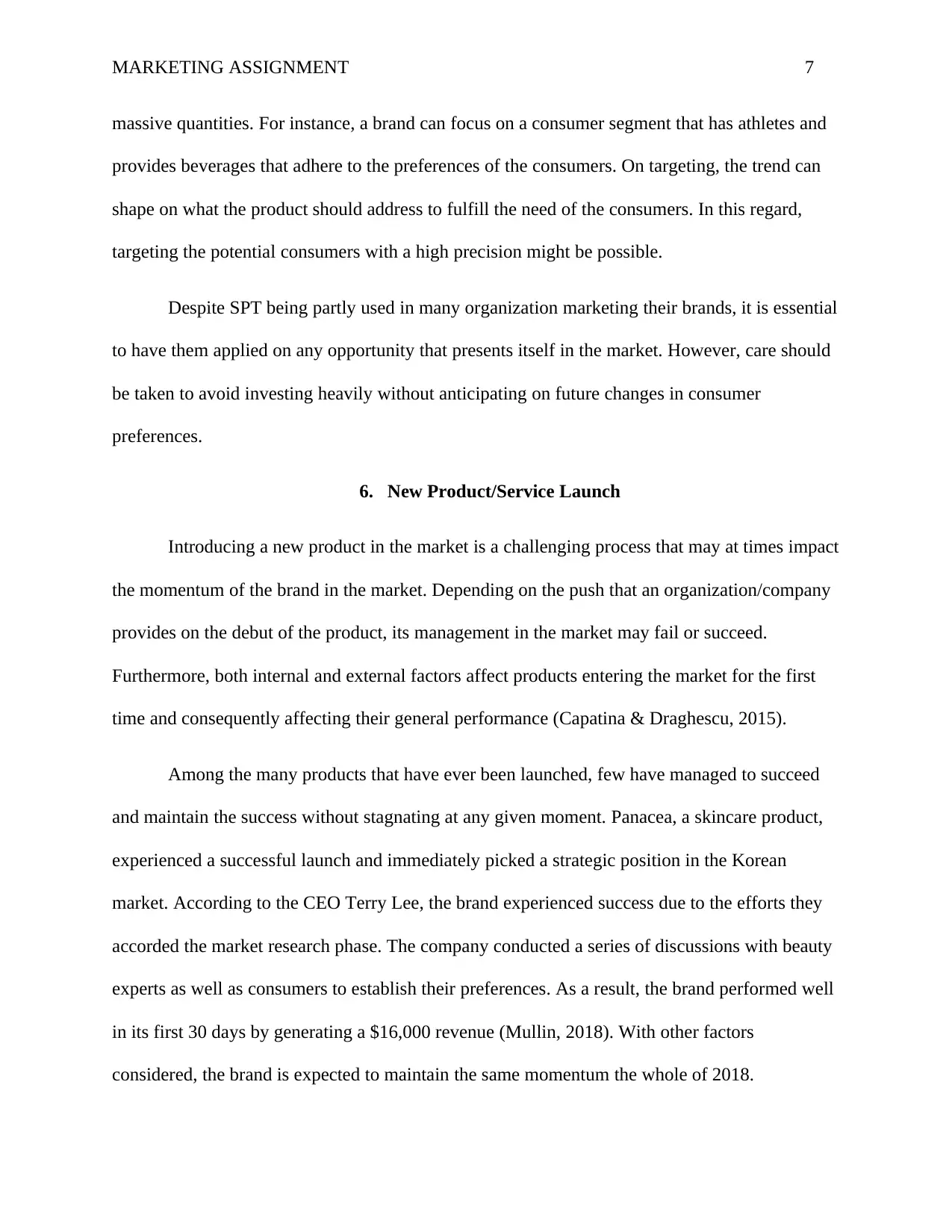
MARKETING ASSIGNMENT 7
massive quantities. For instance, a brand can focus on a consumer segment that has athletes and
provides beverages that adhere to the preferences of the consumers. On targeting, the trend can
shape on what the product should address to fulfill the need of the consumers. In this regard,
targeting the potential consumers with a high precision might be possible.
Despite SPT being partly used in many organization marketing their brands, it is essential
to have them applied on any opportunity that presents itself in the market. However, care should
be taken to avoid investing heavily without anticipating on future changes in consumer
preferences.
6. New Product/Service Launch
Introducing a new product in the market is a challenging process that may at times impact
the momentum of the brand in the market. Depending on the push that an organization/company
provides on the debut of the product, its management in the market may fail or succeed.
Furthermore, both internal and external factors affect products entering the market for the first
time and consequently affecting their general performance (Capatina & Draghescu, 2015).
Among the many products that have ever been launched, few have managed to succeed
and maintain the success without stagnating at any given moment. Panacea, a skincare product,
experienced a successful launch and immediately picked a strategic position in the Korean
market. According to the CEO Terry Lee, the brand experienced success due to the efforts they
accorded the market research phase. The company conducted a series of discussions with beauty
experts as well as consumers to establish their preferences. As a result, the brand performed well
in its first 30 days by generating a $16,000 revenue (Mullin, 2018). With other factors
considered, the brand is expected to maintain the same momentum the whole of 2018.
massive quantities. For instance, a brand can focus on a consumer segment that has athletes and
provides beverages that adhere to the preferences of the consumers. On targeting, the trend can
shape on what the product should address to fulfill the need of the consumers. In this regard,
targeting the potential consumers with a high precision might be possible.
Despite SPT being partly used in many organization marketing their brands, it is essential
to have them applied on any opportunity that presents itself in the market. However, care should
be taken to avoid investing heavily without anticipating on future changes in consumer
preferences.
6. New Product/Service Launch
Introducing a new product in the market is a challenging process that may at times impact
the momentum of the brand in the market. Depending on the push that an organization/company
provides on the debut of the product, its management in the market may fail or succeed.
Furthermore, both internal and external factors affect products entering the market for the first
time and consequently affecting their general performance (Capatina & Draghescu, 2015).
Among the many products that have ever been launched, few have managed to succeed
and maintain the success without stagnating at any given moment. Panacea, a skincare product,
experienced a successful launch and immediately picked a strategic position in the Korean
market. According to the CEO Terry Lee, the brand experienced success due to the efforts they
accorded the market research phase. The company conducted a series of discussions with beauty
experts as well as consumers to establish their preferences. As a result, the brand performed well
in its first 30 days by generating a $16,000 revenue (Mullin, 2018). With other factors
considered, the brand is expected to maintain the same momentum the whole of 2018.
Paraphrase This Document
Need a fresh take? Get an instant paraphrase of this document with our AI Paraphraser
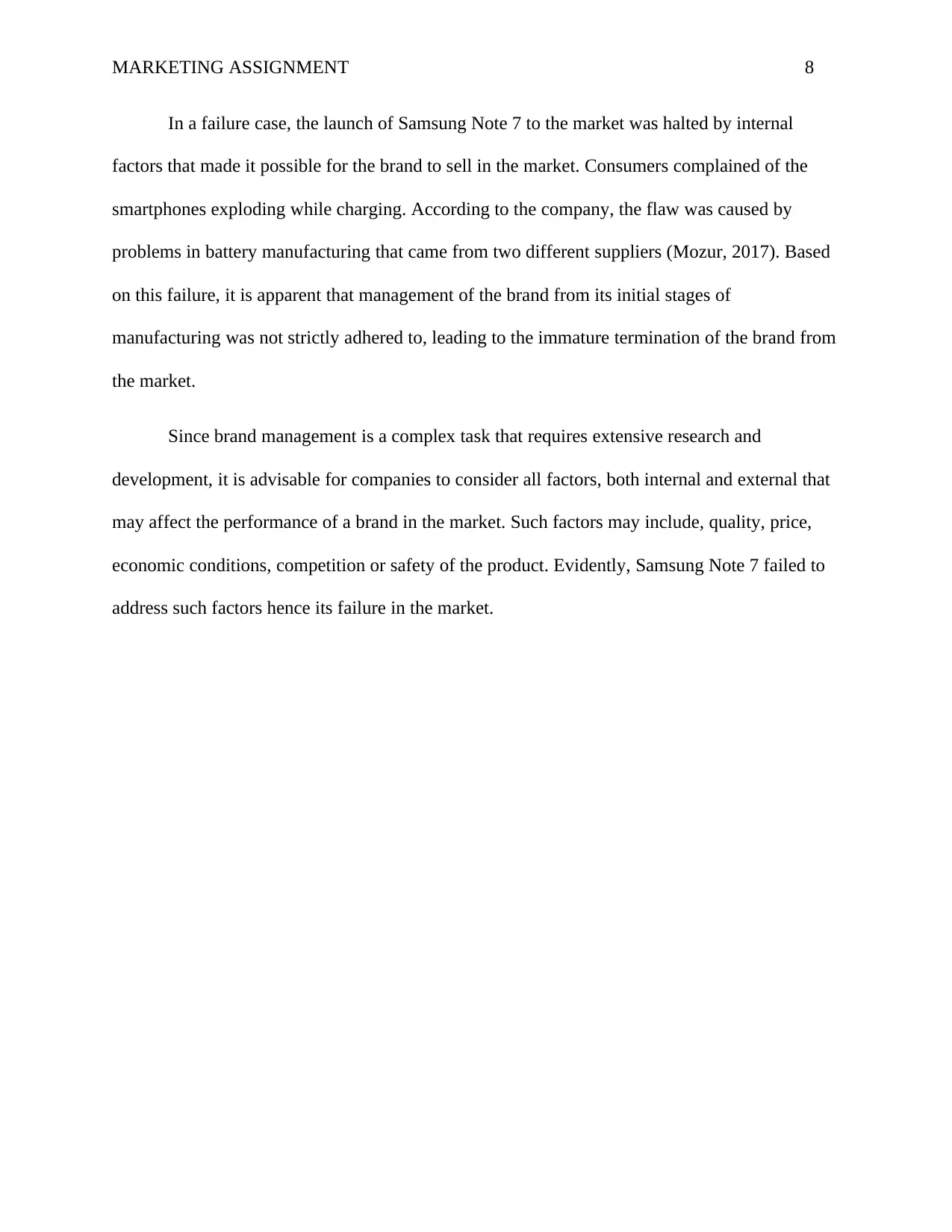
MARKETING ASSIGNMENT 8
In a failure case, the launch of Samsung Note 7 to the market was halted by internal
factors that made it possible for the brand to sell in the market. Consumers complained of the
smartphones exploding while charging. According to the company, the flaw was caused by
problems in battery manufacturing that came from two different suppliers (Mozur, 2017). Based
on this failure, it is apparent that management of the brand from its initial stages of
manufacturing was not strictly adhered to, leading to the immature termination of the brand from
the market.
Since brand management is a complex task that requires extensive research and
development, it is advisable for companies to consider all factors, both internal and external that
may affect the performance of a brand in the market. Such factors may include, quality, price,
economic conditions, competition or safety of the product. Evidently, Samsung Note 7 failed to
address such factors hence its failure in the market.
In a failure case, the launch of Samsung Note 7 to the market was halted by internal
factors that made it possible for the brand to sell in the market. Consumers complained of the
smartphones exploding while charging. According to the company, the flaw was caused by
problems in battery manufacturing that came from two different suppliers (Mozur, 2017). Based
on this failure, it is apparent that management of the brand from its initial stages of
manufacturing was not strictly adhered to, leading to the immature termination of the brand from
the market.
Since brand management is a complex task that requires extensive research and
development, it is advisable for companies to consider all factors, both internal and external that
may affect the performance of a brand in the market. Such factors may include, quality, price,
economic conditions, competition or safety of the product. Evidently, Samsung Note 7 failed to
address such factors hence its failure in the market.
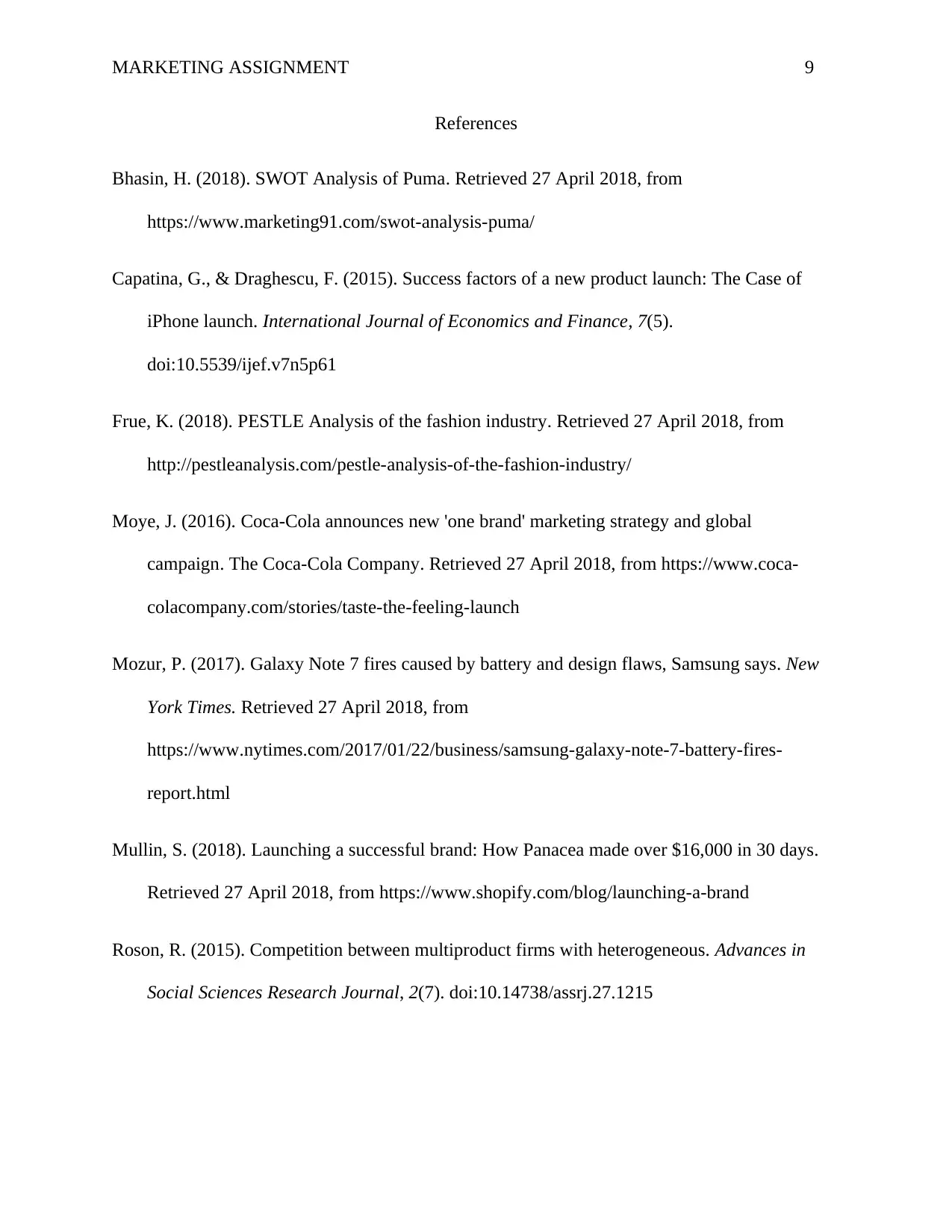
MARKETING ASSIGNMENT 9
References
Bhasin, H. (2018). SWOT Analysis of Puma. Retrieved 27 April 2018, from
https://www.marketing91.com/swot-analysis-puma/
Capatina, G., & Draghescu, F. (2015). Success factors of a new product launch: The Case of
iPhone launch. International Journal of Economics and Finance, 7(5).
doi:10.5539/ijef.v7n5p61
Frue, K. (2018). PESTLE Analysis of the fashion industry. Retrieved 27 April 2018, from
http://pestleanalysis.com/pestle-analysis-of-the-fashion-industry/
Moye, J. (2016). Coca-Cola announces new 'one brand' marketing strategy and global
campaign. The Coca-Cola Company. Retrieved 27 April 2018, from https://www.coca-
colacompany.com/stories/taste-the-feeling-launch
Mozur, P. (2017). Galaxy Note 7 fires caused by battery and design flaws, Samsung says. New
York Times. Retrieved 27 April 2018, from
https://www.nytimes.com/2017/01/22/business/samsung-galaxy-note-7-battery-fires-
report.html
Mullin, S. (2018). Launching a successful brand: How Panacea made over $16,000 in 30 days.
Retrieved 27 April 2018, from https://www.shopify.com/blog/launching-a-brand
Roson, R. (2015). Competition between multiproduct firms with heterogeneous. Advances in
Social Sciences Research Journal, 2(7). doi:10.14738/assrj.27.1215
References
Bhasin, H. (2018). SWOT Analysis of Puma. Retrieved 27 April 2018, from
https://www.marketing91.com/swot-analysis-puma/
Capatina, G., & Draghescu, F. (2015). Success factors of a new product launch: The Case of
iPhone launch. International Journal of Economics and Finance, 7(5).
doi:10.5539/ijef.v7n5p61
Frue, K. (2018). PESTLE Analysis of the fashion industry. Retrieved 27 April 2018, from
http://pestleanalysis.com/pestle-analysis-of-the-fashion-industry/
Moye, J. (2016). Coca-Cola announces new 'one brand' marketing strategy and global
campaign. The Coca-Cola Company. Retrieved 27 April 2018, from https://www.coca-
colacompany.com/stories/taste-the-feeling-launch
Mozur, P. (2017). Galaxy Note 7 fires caused by battery and design flaws, Samsung says. New
York Times. Retrieved 27 April 2018, from
https://www.nytimes.com/2017/01/22/business/samsung-galaxy-note-7-battery-fires-
report.html
Mullin, S. (2018). Launching a successful brand: How Panacea made over $16,000 in 30 days.
Retrieved 27 April 2018, from https://www.shopify.com/blog/launching-a-brand
Roson, R. (2015). Competition between multiproduct firms with heterogeneous. Advances in
Social Sciences Research Journal, 2(7). doi:10.14738/assrj.27.1215
⊘ This is a preview!⊘
Do you want full access?
Subscribe today to unlock all pages.

Trusted by 1+ million students worldwide
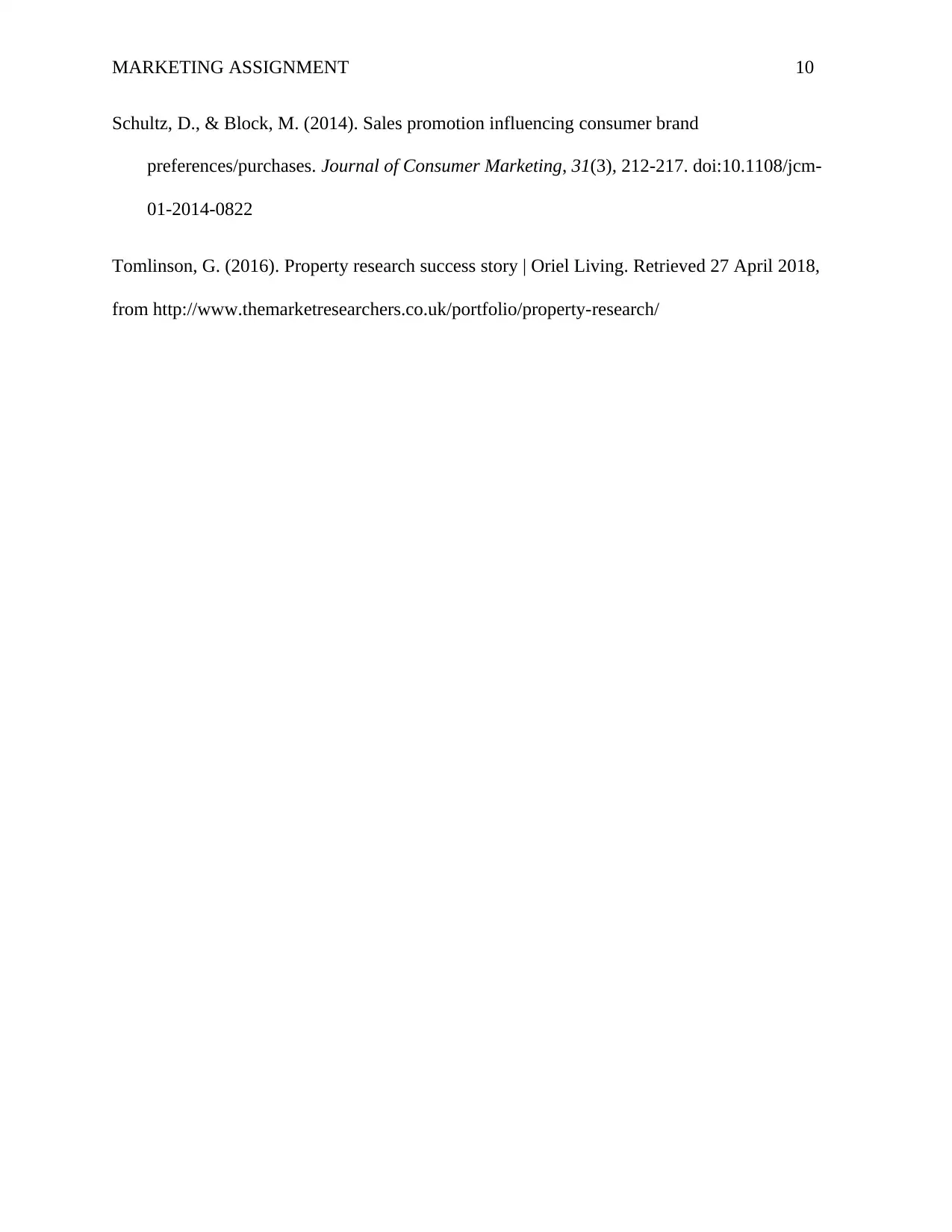
MARKETING ASSIGNMENT 10
Schultz, D., & Block, M. (2014). Sales promotion influencing consumer brand
preferences/purchases. Journal of Consumer Marketing, 31(3), 212-217. doi:10.1108/jcm-
01-2014-0822
Tomlinson, G. (2016). Property research success story | Oriel Living. Retrieved 27 April 2018,
from http://www.themarketresearchers.co.uk/portfolio/property-research/
Schultz, D., & Block, M. (2014). Sales promotion influencing consumer brand
preferences/purchases. Journal of Consumer Marketing, 31(3), 212-217. doi:10.1108/jcm-
01-2014-0822
Tomlinson, G. (2016). Property research success story | Oriel Living. Retrieved 27 April 2018,
from http://www.themarketresearchers.co.uk/portfolio/property-research/
1 out of 10
Related Documents
Your All-in-One AI-Powered Toolkit for Academic Success.
+13062052269
info@desklib.com
Available 24*7 on WhatsApp / Email
![[object Object]](/_next/static/media/star-bottom.7253800d.svg)
Unlock your academic potential
Copyright © 2020–2025 A2Z Services. All Rights Reserved. Developed and managed by ZUCOL.




